
 |
|
How To Use Holsters~ I am sometimes asked to explain the way my holsters work, so here goes ~
All the holsters PICTURED on this site are for RIGHT HAND use. I do make LEFT hand holsters.
=Front Pocket Holster = Below shows the front and back of the limited edition holsters. This is typical of all my holsters, the gun shape is to the body, flat side is out, to minimize print.  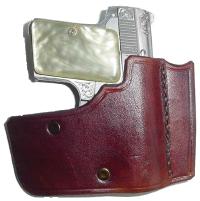
=Back Pocket Holster = This panel faces to the outside, away from the body to hide the print of the weapon. The fingers go between the weapon and the panel, forming a wedge. This original feature keeps the holster in the pocket as the weapon is drawn. To draw a weapon from a right hand holster in the RH back pocket, the palm of your hand will be towards your butt, in a natural way. If you insist on the old method of drawing, with your palm out away from body, order a LEFT HAND HOLSTER and carry it in your right back pocket. Or vice-versa for the left handed user.

Holster AdjustmentThis is the way I suggest you *adjust* your holster, if you feel it is too tight. Lay the leather strip inside your dry (do not wet) holster. 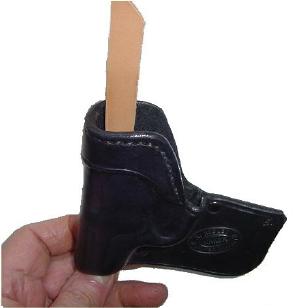 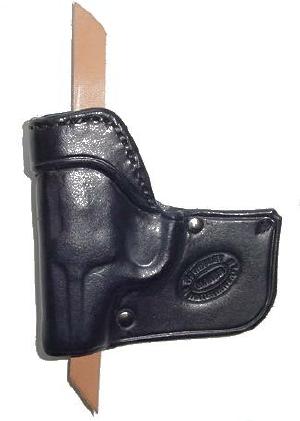 Then insert the gun. Then insert the gun. 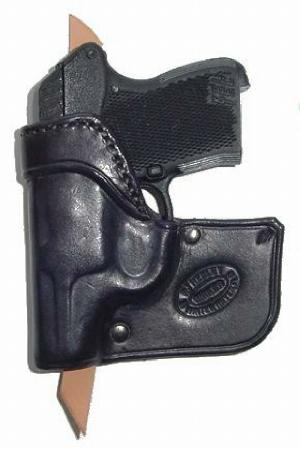 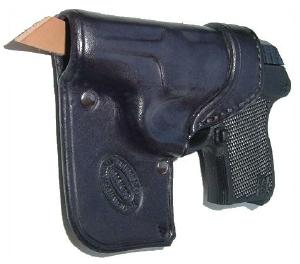 Leave 30 seconds, remove the gun , fit is looser. Want even more looseness, re-insert and leave a little longer. Leave 30 seconds, remove the gun , fit is looser. Want even more looseness, re-insert and leave a little longer.
~~CAVALRY DRAW~~[A term I introduced to Pocket Holster usage, to describe the way a weapon is drawn.] In the days of the horse mounted soldiers known as the "Cavalry", the pistols they carried were very long compared to today's Pocket Pistols. These sidearms were carried "butt forward", in order to be carried comfortably and accessible from a seated position. As revolvers got a bit shorter, many were carried by many members of society, in pockets, Hand Muffs and other hidden places. Pocket holsters were mainly for the hip pocket and did not completely conceal. All the Pocket Holsters used what was known as the "Cavalry Draw" until the modern day Holster Makers changed the attachment of the "Anti-Print Panel "[APP]. One famous maker attached his "APP" by stitching parallel to the gun barrel. I saw the advantage to this, but felt it limited the access to the weapon somewhat and never adapted this method, but instead, I made the attachment point at the bottom, which I call a "Bottom Hinge Point". This met with some confusion from some of the "Old School" guys and lead to the usage of the term, "Cavalry Draw", which lead to even more explanations....
Here is my description of Cavalry Draw for pocket holsters.. Weapon carried on strong side with gun butt to the outside. This requires the hand to be turned Palm Out [ and with Elbow out, I might add ] and the weapon was raked out with the finger tips. And as this is not enough to discourage this method, the muzzle crosses the body, as weapon is drawn, and under stress. If you prefer this method, and you are right handed, just order the Left hand holster. If you are Left handed, order the Right hand holster. Hope this clears up the my meaning of the term, "the Cavalry Draw." Hope this helps,Lisa K
|
![]()
Page hosted by iPowerWeb, Inc.
Copyright © 2003 Hedley Holsters or it's respective owners. All rights reserved.